
Joint effort of CNCR researchers Ka Wan Li, Danielle Posthuma, Guus Smit and researchers from Leuven University (Belgium) shed new light on the role of the CYFIP1 gene. This gene has been linked to various neurological disorders, including intellectual disability, autism and schizophrenia.
A concerted research effort of CNCR researchers Ka Wan Li, Danielle Posthuma, Guus Smit and researchers from Leuven University (Belgium) shed new light on the role of the CYFIP1 gene. This gene has been linked to various neurological disorders, including intellectual disability, autism and schizophrenia. The protein is found postsynaptically where it has its function.
Li used his high-end proteomics technologies to determine the interacting proteins of CYFIP1. The idea was that an outline of this so-called interactome might indicate synaptic proteins residing in the CYFIP1 complex.
“We are lucky to provide evidence for the existence of two different CYFIP complexes‚, Guus Smit explains. “One interaction set encompasses the translational inhibitory complex, the other one termes the WAVE complex. The translational inhibitory complex is involved in the translation of synaptic mRNA into protein. The WAVE complex is involved in actin polymerization‚.
Through an extended series of experiments, the team showed that growth factor BDNF induced synaptic signaling released CYFIP1 from the inhibitory translational complex, triggering translation of target mRNAs and shifting CYFIP1 into the WAVE regulatory complex. Also the mechanism by which CYFIP changes conformation, a prelude for the shift, was identified. CYFIP1 thus orchestrates two molecular cascades, protein translation and actin polymerization. Each of which is necessary for correct synapse structure in neurons.
Using genetic data, Danielle Posthuma confirmed the importance of CYFIP1 by showing that the CYFIP1 interactome revealed many genes associated with different brain disorders. This opens new perspectives to define regulatory pathways shared by neurological disorders, which are characterized by spine structure abnormalities.
The work was published in Neuron: Neuron. 2013 Sep 18;79(6):1169-82..